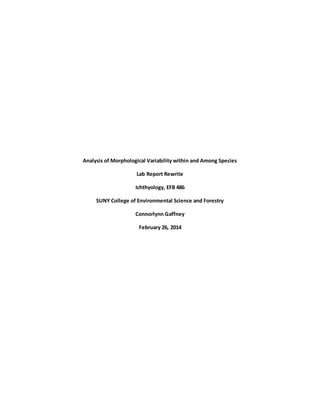
labreport morphology rewrite
- 1. Analysis of Morphological Variability within and Among Species Lab Report Rewrite Ichthyology, EFB 486 SUNY College of Environmental Science and Forestry Connorlynn Gaffney February 26, 2014
- 2. Abstract Animal speciesare dividedbasedon differencesandsimilarities.Some speciesare relatedmore closelythanothersandrequire small detailstodistinguishthe differences.Asagroupof four,we measured120 differentspecimensforstandardbodylength,eye diameter,andthe anal finrays or spines.We attemptedtodistinguishthe difference between twosetsof similarspecies:the Centrachids; rock bass (Ambloplitesrupestris) and pumpkinseedsunfish(Lepomisgibbosus), andthe Salmonines; rainbowtrout(Onchohynchusmykiss),andcoho salmon(Onchohynchuskisutch).Comparingthe morphometricandmeristiccharacteristicsaslookedforevidence of allometricvariations. We discoveredthatthe mostaccurate representationof aspeciesinvolvesthe anal fin,where asthe standardbodylengthis one of the leastaccurate formsof measurementbetweenspecies. Introduction All livingthingscanbe separatedintospeciesbasedonaset of generalizedrulesaboutthe individuals. Thislabusesthe phenticspeciesconceptwhichassignsspeciesbased oncountable or measureable characteristics.Thisspeciesconceptalsotakesallometryintoaccount whenseparating species. Thislabattemptstouse morphometriccharacteristicssuchasstandard bodylength,andthe meristiccharacteristicof anal finraysto distinguishthe differencebetweentwoclosely relatedspecies pairs. Due to the variationamongstindividualsof aspeciesitcan be hypothesizedthatthe meristic characteristicwill be more reliable todistinguishthe difference betweenspeciesthanthe morphometric characteristics.Thislabalsoattemptstolookfor allometricvariationamongst speciesanddetermine if those measurementsare validarguments todistinguishdifferentspecies.Itcouldbe hypothesizedthat some specieshave the same ratioof eye size tobodylengthregardlessof the actual size of the fish. Methods The class splitintogroupsto measure variousmorphologicaltraitsinfourdifferentspeciesof fishfromtwodifferentfamilies;rockbass(Ambloplitesrupestris), pumpkinseedsunfish(Lepomis gibbosus),rainbowtrout(Oncorhynchusmykiss ),andcohosalmon(Onchohynchuskisutch).The first twoare centrarchidsfromcentral NewYork,and the secondtwoare non-native tothe Greatlakes watershedthathave adaptedovertime. My labpartnerand I combinedwithanotherpairof labpartnersto getthrough120 different fishspecimens.The fishwere dividedbyspecies,andeachspecieswasseparatedinjarsbasedontheir general size.We measuredtenindividualsfromeachjar,or thirtyof each species.Inordertoproceed withthe mostefficiencywe dividedthe tasksbetweenthe membersof ourgroup. In the centarchidspecies,the rockbassandpumpkinseed,we were responsible formeasuring standardlength,eye diameter,andcountingthe anal spines,butnotthe branchedrays.The branched rays are segmented.Inordertoidentifythe difference,we were instructedtocountfromthe base of the finrather thanthe tipwhere the branchingoccurs.
- 3. The salmonine species,rainbowtroutandcohosalmon,were alsomeasuredforstandard length,eye size,andanal finrayswere counted.These speciesdonothave branchedrays,soall rays were counted. To measure the standardlengthwe usedarulerto measure fromthe headto the hypural plate, rightbefore the tail fin.Thiswasan accurate measure of lengthbecause the tail oneachindividual could have beenalteredfromanaccidentor sittinginthe alcohol forsuchan extendedperiod. The eye size wasone of the mostdifficultthingstomeasure due tothe variationinsizes.We useda verniercaliperonthe inside of the eye sockettofindthe true size withouthavingtoworryabout inaccuraciesdue toeye shrinking. In orderto analyze the dataI createdvarious graphs inexcel,andperformed a2-tailedt-test comparingthe salmonine anal finraysandthe centrarchidanal spines.The graphscreatedinclude the relative eye sizeof the centrarchidsandthe relative eye size of the salmoines.The treadlinesare a comparisonof the bodysize and eye diameterineachindividual.There are also twographsincluded whichdemonstrate the standardbodylengthandnumberof spines/rays. Results Salmonines The degreesof freedomwere 41,and resultsof the t-testwere calculatedtobe significant(t stat=-38.16). The P value,whichisacomparisonof the t-critical and t-stat, waslessthan0.001 witha value of 1.17 x 10-33 . The relative eye size of the salomine speciesisdisplayedonthe figure below.Italsodisplaysthe slope,andR2 valuesonthe treadline.The topvalues (y=3.1809 + 18.054) representthe cohosalmon, and the bottomline (y=0.7052x + 69.721) representthe rainbow trout. y = 0.7052x + 69.721 R² = 0.0112 y = 3.1809x + 18.054 R² = 0.398 0 50 100 150 200 250 0 10 20 30 40 StandardBodyLength(cm) Eye Diameter (cm) Relative Eye Size Salmonine Species Figure 1. Thisgraph displaysthe relativeeye sizeof the two salmonine species.The rainbow troutis representedbythe diamonds,andthe cohosalmonare representedbythe squares.
- 4. The secondgraph (Figure 2) below representsthe comparisonof anal finraysinthe salonine species. The toptreadline (y=-0.0003x + 14.96) representsthe cohosalmon,andthe bottomtreadline (y= 0.0007x + 11.88) representsthe rainbow trout. Centrarchid The degreesof freedomwere 29, and resultsof the t-testwere calculatedtobe significant(t stat= 35. 72). The P value,whichisacomparisonof the t-critical andt-stat,wasless than0.001 witha value of 1.58 x 10-25 . The relative eye size of the centrarchid species isdisplayedonFigure 3below.Italsodisplays the slope,andR2 valuesonthe treadline.The topvalue (y=-0.0013 + 0.2827) representthe rockbass, and the bottomline (y=-0.0002x + 0.1148) representthe pumpkinseed. y = 0.0007x + 11.875 R² = 0.027 y = -0.0003x + 14.958 R² = 0.0037 0 2 4 6 8 10 12 14 16 0 50 100 150 200 250 TotalRays Standard Body Length (cm) Salmonine Rays Figure 2. Thisgraph representsthe numberof anal finraysincomparisonto the standardbodylength.The squares representcoho salmon,andthe diamondsrepresentrainbow trout. y = -0.0013x + 0.2827 R² = 0.7876 y = -0.0002x + 0.1148 R² = 0.3111 0 0.05 0.1 0.15 0.2 0.25 0.3 0.35 0 50 100 150 200 RelativeEyeSize Standard Length (cm) Centrarchid Relative Eye Size Figure 3. Thisgraph displaysthe relativeeye sizeof the two centrarchid species.The rockbassare representedbythe diamonds,andthe pumpkinseedsare representedbythe squares.
- 5. The fourthgraph (Figure 4) below representsthe comparisonof anal spines inthe centrarchid species. The toptreadline (y=0.0018x + 5.80) representsthe rockbass,and the bottomtreadline (y=2E- 16x+3) representsthe pumpkinseed. Discussion In all the speciesstudieditcanbe statedthatthere is evidencetosupportthe hypothesisthat the meristiccharacteristicwill be more reliabletodistinguishthe difference betweenspeciesthanthe morphometriccharacteristics. Figure 1and figure 3 representthe relative eyesize of the individuals. Due to the treadlinescrossingandamountof scatterat the lowerendof the graphs,there are not significantenoughdifferencestouse relative eyesize asatrait intellingtwospeciesapart. Figures2 and 4 showthe relationshipbetween the anal spines/raysandthe size of fish.Ineach graph there isa distinctdifference betweenthe twospeciesrepresentedoneachgraph.The treadlines are separatedenoughthatevenif there wasmore dataincluded,theywouldnotcross.Inthe case of the fewoutliers,they are close enoughtothe treadline thatthere isnochance of confusionwiththe otherdata on the graph. Figures1 and 3 also refute the hypothesis thatsome specieshave the same ratioof eye size to bodylengthregardlessof the actual size of the fish. Itcouldbe statedthat individualsof the salmonine speciesbetween10-20cmhave distinctratiosof eye diameterandstandardbodylength,butthere is not enoughdatato determine if the resultissignificantornot.It couldalso be statedthat rockbass individuals smallerthan50cm have a distinctrelative eyesize whichcouldbe usedtoidentifyspecies differences,althoughinordertohave significantresultsitwouldbe necessarytointentionallyinclude specimensof pumpkinseedswhichmeasuretolessthan50cm long. y = 0.0018x + 5.7936 R² = 0.0408 y = 2E-16x + 3 R² = #N/A 0 1 2 3 4 5 6 7 8 0 50 100 150 200 NumberofAnalSpines Standard Body Length (cm) Centrachids Figure 4. Thisgraph representsthe numberof anal spinesincomparisontothe standardbody lengthof the centrarchidspecies. The diamondsrepresentthe rockbass,and the squaresrepresent the pumpkinseed.
- 6. These differencesbetweenspecies have mostlikelybeenmaintaineddue tothe inabilityof speciestomate withotherspecies.Itcouldalsotake the lackof variationbetweenindividualsof the same speciesinto account.Natural selectionchoosesindividualstosurvive basedonsuperiortraits,in the eventof an individualmutatingtohave adifferenttrait,unlessitcontributestothe individuals survival,the traitwill die outwiththatindividual. The varioustraits amongspeciesare bestusedtoidentifyspecieswhentechnologytoanalyze DNA is unavailable,suchaswhenconductingfieldwork.Understandingthe differencesamongsimilar speciesisimperative forquickidentificationinsituationswhichrequire workwithspecimens.